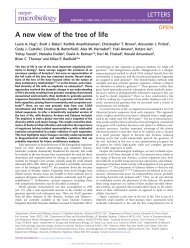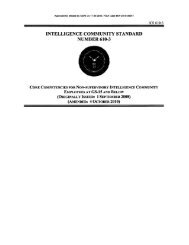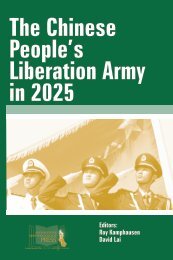The Joint Force in a Contested and Disordered World
JCS-JOE-2035
JCS-JOE-2035
You also want an ePaper? Increase the reach of your titles
YUMPU automatically turns print PDFs into web optimized ePapers that Google loves.
With<strong>in</strong> this context, conflict <strong>and</strong> war are likely to occur as states are unable to cope with <strong>in</strong>ternal<br />
political fractures, environmental stressors, or deliberate external <strong>in</strong>terference. As governments<br />
fail to provide a regular legal framework, to develop economic stability, to adequately respond to<br />
man-made <strong>and</strong> natural disasters, <strong>and</strong> to protect their citizens, they will become susceptible to<br />
violent political action. Ultimately, multiple <strong>in</strong>ternal pressures might eventually cause a state to<br />
shatter, a condition where the central government is no longer capable of provid<strong>in</strong>g effective <strong>and</strong><br />
legitimate governance, creat<strong>in</strong>g security threats that might affect neighbors <strong>and</strong> spread regionally.<br />
Weak <strong>and</strong> fragile states might become the target of more capable external powers that will<br />
<strong>in</strong>creas<strong>in</strong>gly exploit <strong>in</strong>ternal political, ethnic, or economic fractures to further their own strategic<br />
<strong>in</strong>terests. States under stress may also shatter due to these external pressures. Additionally, these<br />
states once shattered, may then be forcibly partitioned, subdued, or reconnected by more powerful<br />
states, or even very capable non-state or transnational actors. Moreover, damage result<strong>in</strong>g from<br />
the chaos of shattered <strong>and</strong> reordered regions is not limited to the areas ostensibly under the control<br />
of the weak state, but will have consequences for the wider <strong>in</strong>ternational system.<br />
Conflict <strong>in</strong> this context will have a significant urban dimension. <strong>The</strong> lack of connections between<br />
new urban migrants <strong>and</strong> established social structures can potentially lead to friction among<br />
sectarian or ethnic groups, <strong>and</strong> potentially result <strong>in</strong> the section<strong>in</strong>g of cities by religious or ethnic<br />
affiliation. Alienation of populations with<strong>in</strong> these areas caused by both poverty <strong>and</strong> the<br />
disorientation of formerly rural residents <strong>in</strong>teract<strong>in</strong>g with more cosmopolitan urban citizens may<br />
<strong>in</strong>crease the potential for crim<strong>in</strong>al <strong>and</strong> gang-related activities as well as the development of urban<br />
<strong>in</strong>surgent groups. Furthermore, the economic, social, <strong>and</strong> political unravell<strong>in</strong>g of a city,<br />
particularly a megacity, would overwhelm the capacity of most states <strong>and</strong> global humanitarian<br />
response communities to effectively respond.<br />
Nature of Potential Adversaries<br />
Ineffective governance <strong>in</strong> weak states can ultimately lead to the emergence of sub-state actors who<br />
oppose or seek to overthrow rul<strong>in</strong>g authorities. While some groups will have legitimate grievances<br />
aga<strong>in</strong>st the state, others will exploit weakness by the central government as justification to seize<br />
power, resources, or strategic territory. Increas<strong>in</strong>gly, national borders may be challenged as<br />
unresponsive to local political aspirations. Consequently, as <strong>in</strong>ternal authority is challenged <strong>and</strong><br />
beg<strong>in</strong>s to collapse, violence is likely to occur <strong>in</strong> the form of sectarian strife, ethnic conflict, or even<br />
civil war.<br />
Shattered states are often safe havens for crim<strong>in</strong>al <strong>and</strong> extremist organizations, provid<strong>in</strong>g their own<br />
type of order, however violent or illegitimate. Crim<strong>in</strong>al networks <strong>in</strong> these environments serve as<br />
critical hubs to global black markets that traffic <strong>in</strong> drugs, weapons, <strong>and</strong> people. Furthermore,<br />
crim<strong>in</strong>al activity with<strong>in</strong> these shattered zones can become the de facto economy of extremist<br />
organizations operat<strong>in</strong>g <strong>in</strong> the region. Left unchallenged, these crim<strong>in</strong>al networks might become<br />
capable enough to challenge the sovereignty of even function<strong>in</strong>g states.<br />
Shattered regions can also lead to the emergence of violent groups that susta<strong>in</strong> themselves by<br />
disrupt<strong>in</strong>g resource <strong>and</strong> trade routes, which can cause large-scale damage or negative long-term<br />
geopolitical consequences. For example, shattered sovereignty <strong>in</strong> Somalia allowed for poach<strong>in</strong>g<br />
by <strong>in</strong>ternational fish<strong>in</strong>g companies <strong>and</strong> the subsequent decimation of the Somali fish<strong>in</strong>g <strong>in</strong>dustry.<br />
37











